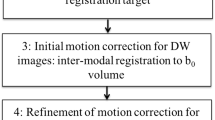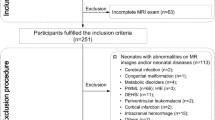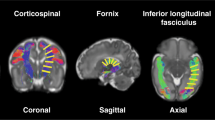Abstract
Background
Diffusion tensor data can be analyzed using region-of-interest (ROI) analysis and tract-based spatial statistics (TBSS). There is essentially no literature validating or comparing these techniques in the neonate.
Objective
The purpose of this study was to perform a direct comparison of fractional anisotropy (FA), axial diffusivity (AD) and radial diffusivity (RD) derived using manual ROI analysis and TBSS modified for use in neonates.
Materials and methods
This study was IRB-approved. Thirty-nine infants, 32–49 weeks post-conception age, underwent MRI at 3 T. FA, AD and RD of the callosal genu (CG) and splenium (CS) and posterior limbs of both internal capsules (PLIC) were determined using both techniques. Pearson correlation (r) was used to estimate the concordance of tensor metrics derived from these techniques.
Results
The r value for FA in the CG, CS and left and right PLIC was 0.88, 0.75, 0.78 and 0.35, respectively. The r value for axial/radial diffusivity in the CG, CS and left and right PLIC was 0.62/0.72, 0.76/0.64, 0.68/0.9 and 0.3/0.72, respectively. The variable concordance results from problems with spatial correspondence of ROI masks between the native space and the FA skeleton.
Conclusion
Direct comparison between these methodologies shows tensor metrics varied with location and by degree, suggesting the two techniques do not provide consistently comparable results.







Similar content being viewed by others
References
Basser PJ, Pierpaoli C (1996) Microstructural and physiological features of tissues elucidated by quantitative-diffusion-tensor MRI. J Magn Reson B 111:209–219
Le Bihan D, Mangin JF, Poupon C et al (2001) Diffusion tensor imaging: concepts and applications. J Magn Reson Imaging 13:534–546
Jespersen SN, Kroenke CD, Ostergaard L et al (2007) Modeling dendrite density from magnetic resonance diffusion measurements. Neuroimage 34:1473–1486
Huppi PS, Maier SE, Peled S et al (1998) Microstructural development of human newborn cerebral white matter assessed in vivo by diffusion tensor magnetic resonance imaging. Pediatr Res 44:584–590
Counsell SJ, Shen Y, Boardman JP et al (2006) Axial and radial diffusivity in preterm infants who have diffuse white matter changes on magnetic resonance imaging at term-equivalent age. Pediatrics 117:376–386
Anjari M, Srinivasan L, Allsop JM et al (2007) Diffusion tensor imaging with tract-based spatial statistics reveals local white matter abnormalities in preterm infants. Neuroimage 35:1021–1027
Ball G, Counsell SJ, Anjari M et al (2010) An optimised tract-based spatial statistics protocol for neonates: applications to prematurity and chronic lung disease. Neuroimage 53:94–102
Ball G, Boardman JP, Rueckert D et al (2012) The effect of preterm birth on thalamic and cortical development. Cerebr Cortex 22:1016–1024
Righini A, Doneda C, Parazzini C et al (2010) Diffusion tensor imaging of early changes in corpus callosum after acute cerebral hemisphere lesions in newborns. Neuroradiology 52:1025–1035
Oishi K, Mori S, Donohue PK et al (2011) Multi-contrast human neonatal brain atlas: application to normal neonate development analysis. Neuroimage 56:8–20
Huang H, Zhang J, Wakana S et al (2006) White and gray matter development in human fetal, newborn and pediatric brains. Neuroimage 33:27–38
Smith SM, Jenkinson M, Johansen-Berg H et al (2006) Tract-based spatial statistics: voxelwise analysis of multi-subject diffusion data. Neuroimage 31:1487–1505
Bassi L, Ricci D, Volzone A et al (2008) Probabilistic diffusion tractography of the optic radiations and visual function in preterm infants at term equivalent age. Brain 131:573–582
Anjari M, Counsell SJ, Srinivasan L et al (2009) The association of lung disease with cerebral white matter abnormalities in preterm infants. Pediatrics 124:268–276
Altaye M, Holland SK, Wilke M et al (2008) Infant brain probability templates for MRI segmentation and normalization. Neuroimage 43:721–730
Jones DK, Horsfield MA, Simmons A (1999) Optimal strategies for measuring diffusion in anisotropic systems by magnetic resonance imaging. Magn Reson Med 42:515–525
Rollins NK, Vachha B, Srinivasan P et al (2009) Simple developmental dyslexia in children: alterations in diffusion-tensor metrics of white matter tracts at 3 T. Radiology 251:882–891
Bland JM, Altman DG (1986) Statistical methods for assessing agreement between two methods of clinical measurement. Lancet 327:307–310
Miller SP, Vigneron DB, Henry RG et al (2002) Serial quantitative diffusion tensor MRI of the premature brain: development in newborns with and without injury. J Magn Reson Imaging 16:621–632
Berman JI, Mukherjee P, Partridge SC et al (2005) Quantitative diffusion tensor MRI fiber tractography of sensorimotor white matter development in premature infants. Neuroimage 27:862–871
Seo Y, Wang ZJ, Morriss MC et al. (2012) Minimum SNR and acquisition for bias-free estimation of fractional anisotropy in diffusion tensor imaging—a comparison of two analytical techniques and field strengths. Magn Reson Imaging 30:1123–1133
Author information
Authors and Affiliations
Corresponding author
Rights and permissions
About this article
Cite this article
Seo, Y., Wang, Z.J., Ball, G. et al. Diffusion tensor imaging metrics in neonates—a comparison of manual region-of-interest analysis vs. tract-based spatial statistics. Pediatr Radiol 43, 69–79 (2013). https://doi.org/10.1007/s00247-012-2527-7
Received:
Revised:
Accepted:
Published:
Issue Date:
DOI: https://doi.org/10.1007/s00247-012-2527-7




